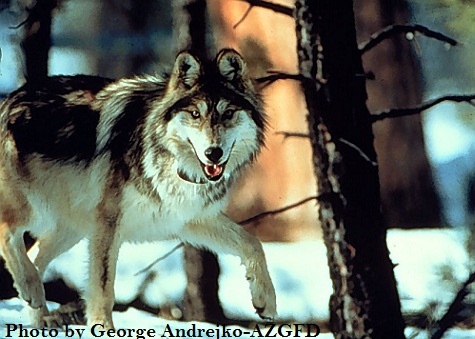Press Release: Feds to Shoot Endangered Mexican Wolf
Center for Biological Diversity
For Immediate Release, August 9, 2012
 SILVER CITY, N.M.— The alpha female of the Fox Mountain Pack of Mexican gray wolves will be shot due to the seven-member pack preying on four head of cattle over several months. The owners of the cattle will be fully reimbursed, but the wolf family will lose their matriarch, according to a kill-order issued Wednesday by the U.S. Fish and Wildlife Service to its sister agency, U.S.D.A. Wildlife Services. Last year, only 58 Mexican wolves and six breeding pairs survived in New Mexico and Arizona, their only home in the wild.
SILVER CITY, N.M.— The alpha female of the Fox Mountain Pack of Mexican gray wolves will be shot due to the seven-member pack preying on four head of cattle over several months. The owners of the cattle will be fully reimbursed, but the wolf family will lose their matriarch, according to a kill-order issued Wednesday by the U.S. Fish and Wildlife Service to its sister agency, U.S.D.A. Wildlife Services. Last year, only 58 Mexican wolves and six breeding pairs survived in New Mexico and Arizona, their only home in the wild.
“Instead of killing this successful wolf mother, more should be done by affected ranchers to protect their livestock,” said Michael Robinson of the Center for Biological Diversity. “This kill order is a shocking return to reviled and destructive Bush administration policies toward Mexican gray wolves. Resources should be used to immediately hire a range-rider, rather than spend a greater amount of taxpayer money to shoot a radio-collared wolf in front of her pups.”
The last wolf shot in response to livestock depredations was the alpha female of the Durango Pack, killed on the Gila National Forest in New Mexico in June 2007. Her mate and pup disappeared thereafter and are presumed dead. Then-governor Bill Richardson withdrew the state’s assent to killing her and other wolves, but his message was delivered too late to save her.
“The Fox Mountain Pack is largely surviving on elk,” said Robinson. “Rare losses of livestock, whose owners are indemnified, should not be used as an excuse to resume a de facto war against the beautiful, intelligent, social and very imperiled Mexican wolf. These pups should be allowed to grow up with their mother.”
After a decades-long wolf extermination program in the United States and Mexico carried out by the U.S. Fish and Wildlife Service, passage of the Endangered Species Act in 1973 led to the rescue and captive breeding of the last five Mexican wolves in the wild in Mexico. Some of their great-grandpups were reintroduced in 1998, but the shooting of 12 wolves by the government, accidental killing of 18 more in the course of capture, and long-term incarceration of 32 other once-wild wolves has led to the population languishing and left it at risk of blinking out.
PLEASE CALL TODAY TO STOP THE SENSELESS KILLING OF THIS WOLF!
Call the White House and USFWS Southwest Regional Director Ben Tuggle now and tell them to keep the Fox Mountain alpha female in the wild with her pups!
White House number: 202-456-1111
US Fish and Wildlife Service Southwest Regional Office number: 505-761-4748
If you live in any of these swing states, please call the local Obama campaign office:
Colorado, Florida, Iowa, Michigan, Nevada, New Hampshire, Ohio, Virginia, or Wisconsin. You can find the nearest Obama campaign office here. http://www.barackobama.com/offices/
Your own words are best, but here’s a simple script for your call:
My name is ____________ and I live in ______________ state.
I support the Mexican wolf recovery effort and I am calling to ask you to stop the killing of the Fox Mountain alpha female.
With only 50-60 Mexican wolves in the wild, every one is important, and this Mexican wolf has pups born just this summer.
There are many solutions to conflicts between livestock and wolves, but there are very few Mexican gray wolves.
The Fish and Wildlife Service needs to release more Mexican wolves into the wild, not kill the ones already there.
Include any personal reasons you have for caring about this and thank them.
Please send us a message at info@mexicanwolves.org to let us know you have called.
If you can’t get through to a person or voicemail tonight, please call in the morning. Calls mean more than emails, but if you can’t call, you can email the USFWS at RDTuggle@fws.gov and Obama at http://www.whitehouse.gov/contact/submit-questions-and-comments. Thank you so much! This is so important.
Thank you for your work to save this Mexican wolf’s life!
Mexican gray wolf photo by George Andrejko, Arizona Game and Fish Department. Photos are available for media use.



